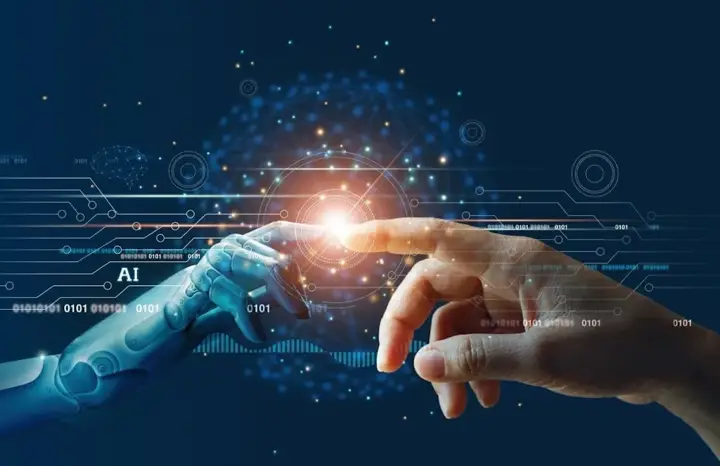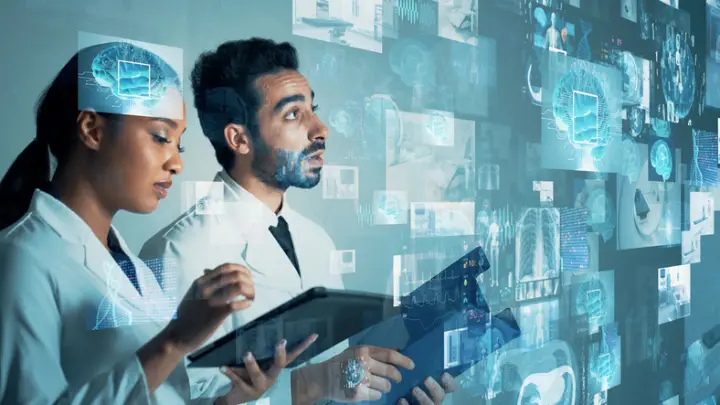AI in Healthcare: Enhancing Diagnostics for Better Patient Outcomes
AI | 09-11-2023 | By Paul Whytock
Some may say the recent World Economics Forum on Artificial Intelligence (AI) achieved nothing. I don’t entirely agree with that. In my view, the forum highlighted some fundamental elements of how the world should progress with the development of AI, emphasising the necessity for a controlled approach to this revolutionary technology.
The forum brought to light the critical balance needed between innovation and regulation. As we delve into the realm of AI, particularly in sensitive areas like healthcare, the conversation shifts from theoretical potential to tangible impact. The ability of AI to not only complement but, in some cases, surpass human expertise in medical diagnostics is a testament to its transformative power. Yet, this power comes with a responsibility to navigate the ethical and regulatory challenges that accompany such profound technological advancements.

The Transformative Power of AI in Healthcare
Consider the transformative power of AI in healthcare, where its application in medical diagnostics is not just a future possibility but a current reality. AI's ability to analyse complex medical data and provide accurate diagnoses is revolutionising the way we approach healthcare, offering hope for faster, more efficient, and more personalised patient care.
The urgency to modernise healthcare through technology has never been more apparent. With systems like the NHS facing immense pressure, the introduction of AI technologies could be a game-changer. AI offers a pathway to not only fix but also future-proof our healthcare services by enhancing diagnostic accuracy, patient care, and operational efficiency. An insightful piece discusses the immediate need for AI integration in the NHS, highlighting the transformative potential of these technologies when applied thoughtfully and ethically.
Now, whereas the UK’s Prime Minister believes it is too early to introduce government legislation here in the UK to regulate AI, it was made clear at the Forum that the EU, United States and China are already implementing controls in an attempt to avoid potential AI dangers.
It was particularly good that China attended the Forum because no international AI regulatory effort would succeed without its involvement. Perhaps Mr Sunak would be wise to reconsider the UK’s position on this if he wants the UK to be a positive member of an international effort to control and develop AI in a sector as critical as healthcare.
One thing is clear when it comes to developing AI: a well-regulated relationship between private enterprises and governments needs to be firmly in place. Beware the overly ambitious and unrestrained developer, especially when the stakes involve human health and lives.
The potential for AI in medical diagnostics is vast, with applications ranging from early detection of diseases to personalised treatment plans. For example, AI algorithms have been instrumental in the development of predictive models for patient outcomes in critical care, as detailed in a study published in Nature.
AI in Medical Diagnostics: A Healthcare Revolution
Turning away from the negative comments about how AI could be the downfall of the human race, let’s look at one of the overwhelming benefits of the technology: medical diagnosis.
It is already recognised that AI presents enormous opportunities when it comes to the analysis of ultrasound, magnetic resonance imaging, mammography, genomics and computed tomography scans. It can also play a pivotal role in the diagnosis of heart disease, dementia, cancer, high blood pressure, diabetes and numerous other diseases.

AI is already proving itself when it comes to analysing the results of medical images. The technology is already demonstrating that it can compete with humans in this area. It can see and rapidly interpret what humans can currently do themselves. In addition, AI can recognise very complex patterns within medical scans that humans struggle with, and it can do this repeatedly all day long without the possible errors that fatigue can inflict on human radiologists.
AI's proficiency in interpreting medical images is underscored by its ability to detect nuances that may escape the human eye. For instance, Google Health's AI model has shown remarkable results in detecting breast cancer in mammography screenings, potentially improving early diagnosis and treatment. Read about Google Health's AI research.
AI's impact on healthcare is multifaceted, with one of the most significant benefits being its potential for cost savings. The NHS has been exploring the use of AI in breast screening, with promising results that suggest a key to cost savings. This is not just about reducing the financial burden on the healthcare system but also about improving patient outcomes through early and accurate diagnosis.
The Crucial Human Element in AI Diagnostics
But humans still have a crucial role to play. AI only exists because of the vast amount of data that is fed into its algorithms. This means sometimes its results can worry doctors because it is unclear how AI has reached its conclusion, and that makes it difficult for medical professionals to confidently concur with AI’s decisions.
The 'Black Box' phenomenon in AI is a significant concern in healthcare, where understanding the rationale behind a diagnosis is as crucial as the diagnosis itself. Efforts to demystify AI's decision-making process are ongoing, with researchers exploring explainable AI (XAI) to make AI's reasoning transparent and reliable for healthcare professionals.
This situation is widely known as the Black Box problem, which means specialist medical staff cannot check for biased or inaccurate AI diagnoses because of a lack of operational transparency on the part of the algorithm.
Quantum Computing's Boost to AI Diagnostics
Algorithms functioning with quantum computers will further increase the medical work AI can offer. In that situation, the enormous quantities of data held by AI could assist with not only diagnosing illness but also making recommendations on what actual treatment a patient needs. It could also lead to AI being able to accurately determine the likely prognosis following such treatment. But more on that later.
The advent of quantum computing promises to exponentially enhance AI's diagnostic capabilities by processing complex biological data at unprecedented speeds. This could lead to significant breakthroughs in personalised medicine, where treatments are tailored to the individual's genetic makeup.
An additional development within the field of AI is the creation of General AI (GAI), which is being used by the likes of OpenAI’s DeepQA, IBM’s Watson, and Google’s DeepMind.
The idea behind GAI in medical applications is all about further improving the speed and accuracy of diagnoses and providing medical staff with information to improve patient recoveries and generally develop better health organisations.
Data Integrity: AI's Diagnostic Reliability
However, as with all development work in AI algorithms, the bottom line is that the system is only as good as the data that creates it and allows it to function. This, if you like, is the Achilles Heel of Artificial Intelligence, and it is this situation which is prompting events like the World Economics Forum on Artificial Intelligence and raising questions related to patient ethics and regulatory limitations that are needed to control AI development but not hinder its potential to help sick people.
The medical data fed into AI must be totally identifiable as complete, authentic, scientifically and medically certified and must also be of geographic relevance to the area of the world where it will be used to diagnose medical conditions.
A recent study showed that a machine learning algorithm used to forecast cancer results focussed on the hospital where the tumour image was taken rather than the patient’s circumstances.
This last point is particularly relevant. Take, for example, lung cancer. Hungary is considered to have a very high rate of this disease, whereas Saudi Arabia has one of the lowest. Accordingly, the AI data being used in each of these countries to diagnose lung cancer must have geographic relevance.
But it’s not just about geographic accuracy. There is also the question of the international compatibility of AI-based medical diagnostic tools.
AI Diagnostic Systems: The Standardisation Challenge
Many different countries and companies are involved in algorithm generation, which again raises the international implementation of regulations and standardisation of systems to ensure that these tools can work together effectively. Without this, systems easily become incompatible. Add to that challenge the situation that different medical organisations may well have imaging equipment set to different operational specifications, and the standardisation question becomes even thornier.

As mentioned earlier, AI algorithms will be able to assist in determining a patient’s prognosis. For example, it will use imaging tests to gather and analyse important information about cancer, such as speed of growth, cell structure and type, whether it has spread, and whether it is likely to come back after treatment. This information can help doctors choose the most appropriate treatment for their patients.
A number of studies suggest that AI has the potential to gather such prognostic information with greater precision than humans currently can. For example, Dr Harmon and her colleagues at America’s Nation Institute of Cancer created a deep learning model that can determine the likelihood that a patient with bladder cancer might need other treatments in addition to surgery.
Doctors estimate that around 50% of people with tumours in the bladder muscle have clusters of cancer cells that have spread beyond the bladder but are too small to detect with traditional tools.
Chemotherapy can kill these microscopic clusters and prevent the cancer from coming back after surgery. However, clinical trials have shown that it’s hard to determine which patients need chemotherapy in addition to surgery.
“What we would like to do is use this model before patients undergo any sort of treatment, to tell which patients have cancer with a high likelihood of spreading, so doctors can make informed decisions,” explained Dr Harmon
Ensuring AI's Long-Term Diagnostic Accuracy
One major question that needs answering about AI’s medical diagnostic abilities is how medical staff can be assured that AI systems will continue to work accurately for many years.
The possible problem is that as new medical hardware such as MRI and CT scanners are implemented, the images they produce may not be precisely the same as the ones the AI algorithm has been working with. This could skew the possible diagnosis. Clearly, there needs to be a close working collaboration between the developers of medical diagnostic equipment and the developers of AI.
But despite all these operational hurdles that AI must jump, it is clear that as a diagnostic tool, it has immense capability.
A study by the Lancet showed that replacing one radiologist with AI for independent reading of screening mammograms resulted in a 4% higher non-inferior cancer detection rate compared with radiologist double reading. The study suggested that AI has the potential for controlled implementation, which would include risk management and real-world follow-up of performance.
Prostate cancer treatment also benefits from AI. Research led by University College London and supported by Prostate Cancer UK and the fund-raising group Movember means doctors could soon provide a man with the most effective treatment strategy for him, tailored to the biology of his specific cancer, at the point of diagnosis – rather than the current one-size-fits-all approach, where treatments are standardised across groups of men.
This would prevent the current delay in waiting to see if a particular treatment is effective. This situation wastes valuable time if it turns out not to be, and the patient then has to try alternative medicines.
AI's impact on cancer treatment is profound, with studies indicating its ability to refine treatment strategies to the unique characteristics of each patient's cancer. This personalised approach, powered by AI, could significantly improve outcomes and reduce the time spent on ineffective treatments.
Embracing the AI Revolution in Healthcare
In conclusion, the discussions at the World Economics Forum have shed light on the critical juncture at which we stand with AI in healthcare. The transformative potential of AI in medical diagnostics is undeniable, offering a future where early detection, personalised treatment, and improved patient outcomes become the norm. However, this future hinges on our ability to navigate the challenges of regulation, data integrity, and the need for international standardisation.
As we have seen, the benefits of AI are tangible and growing, but they come with a caveat: the technology must be developed responsibly and ethically. The involvement of global powers in regulatory discussions is a positive step towards a future where AI can be harnessed safely and effectively. The UK's stance on AI regulation, while cautious, must evolve in tandem with these international efforts to ensure that the healthcare sector remains at the forefront of innovation.
The 'Black Box' problem and the standardisation challenges are significant, but they are not insurmountable. With continued research, collaboration, and transparency, AI can be demystified and integrated into medical practice in a way that complements human expertise.
We stand on the brink of a healthcare revolution, one that promises to redefine our approach to medical diagnostics and treatment. It is incumbent upon us—developers, healthcare professionals, and policymakers—to ensure that this revolution benefits every patient and practitioner. Let us embrace the promise of AI with the seriousness and the commitment it deserves. The future of healthcare depends on it.
To the readers, the call to action is clear: stay informed, advocate for responsible AI development, and support the integration of AI in healthcare that prioritises patient welfare and data ethics. Together, we can steer this revolution towards a future where technology and humanity converge for the greater good of all.

